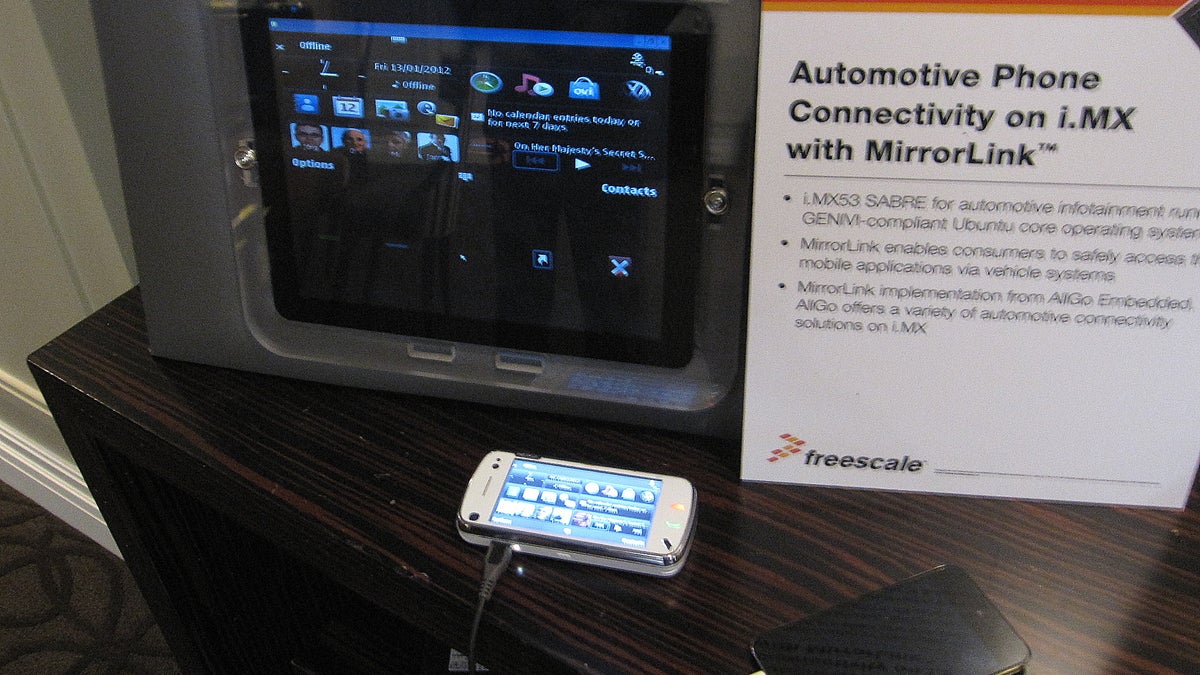Freescale enables iPhone, Android to power automotive infotainment
Freescale, one of the largest makers of automotive silicon, is looking at new ways to integrate smartphones with in-vehicle infotainment systems.

LAS VEGAS--Chip maker Freescale sees smartphone integration as the future of automotive infotainment systems.
Luke Smithwick, who runs the Driver Information and Infotainment Business section of Freescale, points out his daughters as an example of how young people's lives are on their smartphones. And no matter what regulations might be passed, those phones will find a way into the car. So Smithwick's mission is to work on technology that can safely integrate smartphones with driver information systems.
Among its displays here at CES 2012, Freescale had a head unit with its version of MirrorLink enabled, a new technology standard that replicates a smartphone's screen on an external LCD. For this demo, a phone was plugged into the unit through USB, and its screen appeared in larger format on the head unit's touch screen.
Smithwick concedes that MirrorLink is primitive, but it is a place to start. Freescale would build a translation layer into the system, which would put an automotive-appropriate interface on the LCD, with larger icons arranged so as not to take away the driver's attention from the road.
And although this demonstration used a wired connection, Smithwick talked of an enhanced Bluetooth spec that could allow for much more data and control to flow between a touch screen in the dashboard and a smartphone that stays in the driver's pocket.
Freescale also demonstrated a more advanced form of smartphone connectivity that it calls Impresario. This demonstration used a tablet with an iPod cable hanging off of it. With an iPod plugged in, the tablet showed the music library in Cover Flow format.
iPod integration with stereos is nothing new, but with this system, the tablet was showing a translation of the iPod's screen. The iPod's processor was actually driving the display, as opposed to a stereo system in the tablet merely using the iPod as an audio source.
Quad-core processing
Freescale was also touting its new automotive-grade chip, the i.MX6, which goes from single- to quad-core configurations. A surround-view camera system demonstrated the i.MX6 quad-core's capabilities. Similar to surround-view systems deployed by Infiniti and BMW, this system takes the input from four cameras placed around a car, then stitches them together for a virtual top view.
Smithwick pointed out the challenges of such a system, which takes the camera images, connected by Ethernet, and sends them to the central processor. Each image must be time-stamped, as microsecond differences would disrupt the overall image. The central processor stitches the properly time-stamped images together, and shows them quickly enough for the human eye to see them as video.
Freescale announced at the show that its new i.MX6 chip, in single-core format, will power the next generation of GM's OnStar hardware. Previous i.MX generations currently power Ford and GM cabin electronics.
When the subject of competition from the likes of Intel and Nvidia came up, Smithwick pointed out that Freescale has been making automotive-grade silicon for decades. The company supplies everything from engine control chips to the small processors behind power window switches.

